Ask a guitarist to name five famous Les Paul players and you’ll probably get Slash, Jimmy Page, Pete Townsend and Joe Perry… and maybe Ace Frehley, or the late great Gary Moore. There’s plenty of players to choose from: a quick look at the Gibson website reveals that just amongst the models currently on sale there are 23 signature edition Les Pauls!
With so many legends making their name using Gibson’s most famous axe it’s easy to overlook the fact that every one ever made is a signature model of the “Wizard of Waukesha” Les Paul himself.
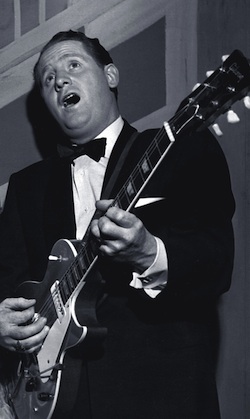
If, at this point, you’re wondering who Les Paul is you’re in good company. When I was a kid I had heard that he was the man who invented the electric guitar, and so I naturally assumed that he must be an engineer who worked for Gibson.
In this series I’m going to explore the life of Les Paul: the only man to be in both the Inventors and the Rock and Roll Hall of Fame, and hopefully demonstrate why I believe he is the greatest example in history of musicianship and innovation acting in perfect (multitracked!) harmony.
First, let’s get a few things straight: Les Paul didn’t invent the electric guitar, the solid body guitar – or even the Gibson “Les Paul”! He did however have a key role in the development of all three. He was also responsible for innovations arguably even more important, which changed the way music would be made forever and paved the way for the jazz and country music of the 40’s to mutate into Sgt. Pepper and Dark Side of the Moon in the 60’s and 70’s.
We’ll start with a look at the classic Gibson “Les Paul” guitar, and Les’ role in its creation. In subsequent parts we’ll be learning about his vast contributions to the art and technology of recording, and audio effects.
Les Paul and the Birth of the Electric Guitar
As a youngster, Les Paul played acoustic guitar and harmonica in a hillbilly act under the name Rhubarb “Red” (where he invented the neck-mounted harmonica holder; but that’s another story).
After a show he was handed a note by an audience member saying “Your act is great, but no one can hear your guitar”. From that day forward he knew he needed to get amplified if he wanted to make the big time.
Before the invention of the amplifier guitars had a tough time in popular music. In the era of big band jazz a guitar just couldn’t compete with a big brass section and a hard hitting drummer. Even smaller combos favoured the banjo which can cut through the noise with percussive chord work. If you did manage to get a gig in a combo with a drummer it was strictly rhythm playing, as a single-note lead line would be drowned out.
The introduction of the magnetic pickup and amplifier revolutionised the roles available to guitar players in much the same way that the electric microphone made it possible for singers like Frank Sinatra to develop new, more intimate vocal techniques.
With the advent of the amplifier came feedback. The first electric guitars were nothing more than traditional acoustic jazz guitars that had been retrofitted with magnetic pickups. Acoustic guitars are designed to resonate. When played without amplification an acoustic guitar vibrates in sympathy with the strings focusing and shaping the sound, but when plugged into an amp the guitar will resonate in sympathy with the sound coming out of the amplifier which will then be transmitted back to the amplifier through the pickups, creating a never ending loop that results in that horrible shrieking sound of feedback.
[Learn more about amplifiers, distortion and feedback]
Les realised that a guitar made of solid wood wouldn’t feed back like a hollow body and furthermore that the notes would sustain better, allowing for more fluid runs like brass instruments are capable of. The Rickenbacker company had been making electric guitars since the 30’s, but these were slide guitars made of metal and shaped like a frying pan.
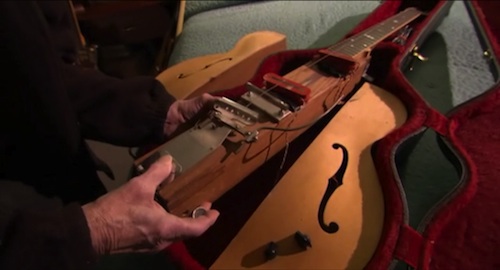
The original Les Paul guitar: 'The Log' (Photo: shannonpatrick17@Flickr)
Les was a great engineer, but knew very little about guitar building so after a few failed attempts (filling his guitar with socks and plaster of Paris!) and a bit of help from the Epiphone factory in 1940, he built a guitar called “The Log” which was made out of a railway sleeper. Les realised that the world wasn’t ready for something that looked so radical and so he attached the wings of a jazz guitar to make it look like something people would recognise.
If you want to know more about the differences between acoustic and electric guitar tone check out Matthew Abdallah’s great article here:
The Gibson “Les Paul”
Les finally had the tone he wanted, but as you can see the log looks like some kind of crazy Frankenstein and not something you would want to play at Carnegie Hall or on TV.
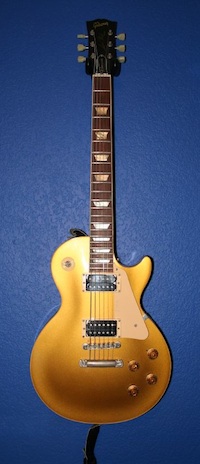
The Gibson Les Paul (Photo: ozoneferd@Flickr)
Les approached the Gibson company who, conservative by nature, dismissed the electronics geek clutching this weird mongrel. The local paper even reported that his crazy ideas created “the combined pandemonium of a four alarm fire, dog fight, curfew chorus and mouse frightened female!”
Ten years down the line, and Gibson were ready to talk. Fender had stolen a march with the launch of the Strat and Tele guitars and Les was now a big name, playing with Bing Crosby and Nat King Cole.
Contrary to popular myth, the Gibson Les Paul guitar was actually designed by the legendary luthier Ted McCarty, with Les acting as a consultant (there is a guitar called the “McCarty” in his honour – but it was designed by Paul Read Smith!) The “Les Paul” reflects both the conservatism of Gibson and its namesake’s status as a hot shot jazz player. The guitar’s shape is essentially that of a downsized, filled-in jazz guitar. It’s a classy and expensive instrument made of mahogany and maple with a glued-in neck joint, embellished with mother of pearl and a flashy gold finish. It is the polar opposite of the bolted-together production line Fender. A Rolls Royce to the Telecasters Model T Ford.
It took a little while to get the design perfected. The first guitars had an awkward bridge (replaced in ‘55 with Ted McCarty’s now industry standard Tune-O-Matic design) and in ‘57 it was upgraded with another industry standard: Seth Lover’s revolutionary PAF humbucking pickup.
The answer to a question no-one asked
Gibson Les Paul guitars dating from the 1950’s are far and away the most valuable electric guitars ever built and can fetch hundreds of thousands of dollars at auction. The reason for this is a slight aside from the life of Les himself, but it’s interesting story so I’ll touch on it briefly.
You may be surprised to hear that the Gibson Les Paul was not a huge success at launch. While certainly not a flop, jazz musicians have never really embraced the solid body guitar and even today if you ask to see a “jazz guitar” in a shop you will be shown a archtop hollowbody. The main market for electric guitars was in country, or surf music where the twangy sound of the Fender Telecaster was far more suitable. As a result the Les Paul was redesigned in 1960 to be thinner with a double cut away and the maple top was dropped. Though Les posed for a few publicity shots he never liked the guitar and asked that Gibson stopped associating it with his name. The Gibson Les Paul was dead (though renamed as the “SG” the new model went on to have great success in the hands of rockers Angus Young and Tony Iommi).
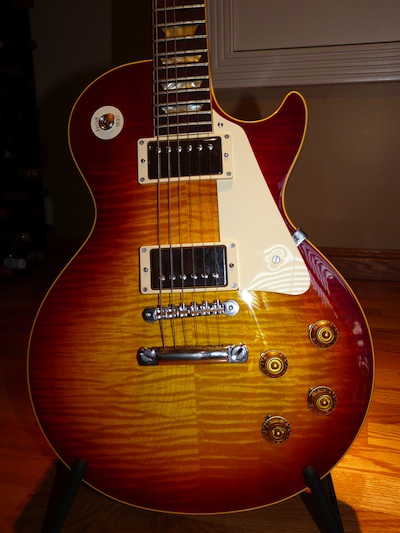
The classic cherry sunburst Les Paul (Photo: eprater@Flickr)
That would have been the end of the story were it not for the 60’s guitar aces of the British invasion twisting blues into a new music called ‘rock’. Though designed before the music even existed, the forgotten Les Paul was the perfect rock guitar. The mahogany and maple body coupled with the set neck give it a rich sustaining tone with focused mid frequencies that cut through the mix while the patented humbucking pickups would drive their beloved Marshall amplifiers into creamy compressed overdrive. Once this was discovered by Keith Richards in ‘64 anyone who was anyone had to have a Les Paul. Jimmy Page, Eric Clapton, Jeff Beck, Peter Green and Pete Townsend were all converts.
Any young axe-slinger showing up at the guitar shop with a bag of crisp tenners wanting to buy a the Les Paul model to be like their heroes would be sorely disappointed to find it had been discontinued. The guitar gained a mythical status and the second hand value went through the roof. “Perhaps,” many wondered, “this rare guitar is how the greats get their tone”.
Gibson finally caved in 1968 and reissued the guitar, but by now the company was under new management and many considered the reintroduced Les Paul as a pale imitation of its former self. The only way to own a “real” Les Paul was to get one of the 50’s originals and only 643 of the most desirable model, the cherry sunburst ‘59 “Standard”, were ever made. It’s often called the Stradivarius of the guitar world.
However, anyone lusting after this rare beast would do well to note that Les himself favoured the unloved 1972 Les Paul “Recording” model – and often said that modern guitars were as good or better than their vintage equivalents!
Classic Les Paul Tone
The role of hard rock in the continuing popularity of the Gibson Les Paul means that the term “Les Paul Tone” usually refers to a thick, sustaining overdrive sound rather than the bright, clean tones of the man himself.
If you want to immerse yourself in classic Les Paul tones here’s my short list:
- Fleetwood Mac – Black Magic Woman




Possibly the greatest blues player of the British invasion demonstrates a sweet blues tone. - Led Zeppelin – Whole Lotta Love



The essential classic rock Les Paul crunch as demonstrated by Jimmy Page. - The Sex Pistols – Pretty Vacant




Steve Jones shows the raw punk power of the Les Paul. - Gary Moore – Parrisienne Walkways




A saturated neck pickup overdrive tone. Famous for the infinite sustain of “that note” around the two-minute mark. - Guns & Roses – Sweet Child O’ Mine




80’s rock was all about pointy fluorescent guitars, until the man in the top hat unleashed the ultimate guitar shop riff…
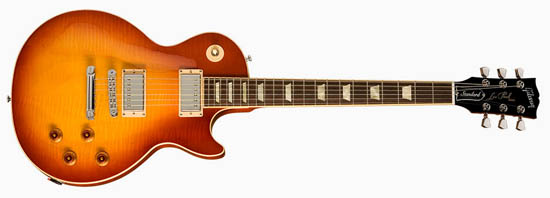
Buying a Les Paul
If listening to some classic cuts has got you itching for your very own Les Paul you will find yourself spoiled for choice, as there are now dozens of models to choose from and most brands make a Les Paul style guitar.
Common variants of the dual humbuckered, maple topped “Standard” include the solid mahogany with ebony fingerboard “Custom” and the single coil pickup equipped “Special”. Les Paul “Junior” models are unadorned student models with a thinner body and are essentially a different (but very cool) guitar.
A final important choice is between the chunky 50’s neck and the much slimmer 60’s profile.
The modern Gibson Les Paul Standard is a superb guitar, but buying one won’t leave you with much change from two thousand pounds. If your budget won’t stretch that far the natural choice is Gibson’s Chinese made sister brand Epiphone who make budget versions of all the popular Gibson USA models for less than a quarter of the price. The build quality of the budget Epiphone guitars is legendary and there is a common myth that they are deliberately fitted with inferior pickups to differentiate them from Gibson models. Whether or not there is any truth in this rumour an Epiphone retro-fitted with aftermarket pickups will give a Gibson original a run for its money in the tone department.
There are plenty of Les Paul tribute guitars from other manufacturers. Vintage make fantastic value guitars in a range of classic styles and the Gordon Smith Graduate is a superb value British-made guitar.
If you are thinking about buying second hand, try before you buy: many Les Pauls from the 70’s and 80’s can be very heavy and can be hit-or-miss in their build quality. I’ve played an 80’s Les Paul “Custom” I wouldn’t pay a hundred quid for! My top tip for a vintage bargain is the 1970’s Yamaha SG1000 which was the equal of the Gibson in both price and tone when new, and can be found second-hand on eBay for a fraction of the price.
The Les Paul Tone Test
I’ve pointed you at some models to try, but how do you know if you’ve found a good one?
The most common flaw in budget Les Paul copies is muddiness (a Les Paul aficionado friend describes them as “sounding like the tone control should be able to turn another quarter twist”). Played clean the neck pickup should have a warm jazzy quality with each string distinct when strummed – even with the tone turned down. Overdriving this sound should produce “Woman tone”, demonstrated here by Clapton on an SG at 2 minutes in:
The bridge pickup should be biting but never shrill, growing into a focused classic rock tone as you add more drive. If you intend to play metal, check that it can cope with heavy drive without becoming mushy, as heavy metal Les Paul slingers like Zakk Wilde usually use EMG or similar metal-focused pickups.
My final tip is this: if you try and test it in the shop by playing the intro to Sweet Child O’ Mine… Don’t be surprised if you feel a hand on your shoulder and and a voice asking you politely but firmly to leave!
What d’you think of the Gibson Les Paul? We want to hear your take on it, and on the man himself – don’t be shy, speak up in the comments below!
In the next part of the series we’ll be looking at Les Paul’s contribution to audio recording techniques: Not to be missed!

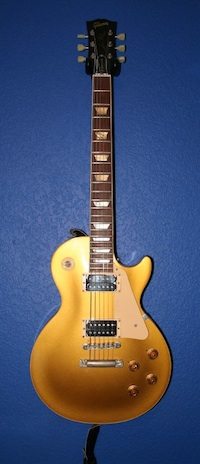







Some interesting discussion of this article on Music Radar: http://www.musicradar.com/forum/showthread.php?t=…
Forum member ES Blonde pointed out two of my sound samples (Black Magic Woman and Parrisienne Walkways) were recorded with the same guitar and has helpfully provided a further reading list:
Gibson Guitars, Ted McCarty's Golden Years 1948-1966 by Gil Hembree
Gibson Electrics, the classic years by A R Duchossoir. The brown cover with an archtop and an SG on the cover. (not the white cover version just called Gibson Electrics, the 'classic years' version is a twenty year update and more accurate)
The Beauty and the burst, by Yasuhiko Iwanade. A couple of hundred pages of colour shots of real bursts, pure guitar porn, then about 25 pages of detailed analysis by the author on the intricacies and variancies of actual examples and their construction.